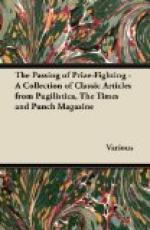of the select reading public. He took up the
first, read a few sketches of
Our Churchwardens,
but failing to appreciate the subject, returned it
to the bag, and went in for
Monsignor.
Perhaps the weak state of health in which our engine
found itself, had not been improved by the additional
weight imposed on it, owing to having to carry
Monsignor.
“Uncommonly heavy,” said the Baron, when
he arrived at the hundredth page; “I will keep
it in reserve for my lighter and gayer moments, when
timely repression may be necessary.” So
saying, he restored this to the same receptacle, and
made another dip in the lucky bag. This time he
brought to the surface
The Case of George Candlemas,
by GEORGE SIMS. Very nearly giving it up was the Baron,
on account of its title, so suggestive of the usual
vein of shilling shockers, and very glad is he that
he did not do so, as for the next hour and a quarter
not only was the Baron really interested, but highly
amused, and it would have done the heart of GEORGE
SIMS, of
Horrible London and other emotional
tales, good to have seen the Baron chuckling over
this capital short story, which is as ingenious as
it is genuinely droll. It belongs to the same
genus as the
Danvers Jewels, though, in this
latter, the idea of the character of the narrator
is more humorously conceived than is Mr. SIMS’s
Baronet who acts as an amateur detective. The
Baron highly recommends this story, as he also does
a short tale in
Blackwood, for this month,
entitled,
A Physiologist’s Wife, by A.
CONAN DOYLE.
The Baron’s attention has been turned to five
little volumes of Love Tales, English, Irish,
Scotch, American, and German. They form a companion
set to Weird Tales, published also by PATERSON
& Co., and a pocketable size, most useful for travellers.
A propos of Travellers, why does not some English
firm bring out a series of Guide-books, of the size,
and written in the style of the Guides Conty,
which, for travelling in France, are far and away
the best Guide-books I know. The Guides Joanne
are of course good, steady, trustworthy Guides, but
they don’t attract the traveller’s attention
to out-of-the-way places, and to the “things
to do,” in the same pleasant way as do the writers
in the Guides Conty. Where to go, when
to go, how to go, how to make the most of a short visit,
what to ask for, what to look for, what to take, and
what to avoid, these are details for which the Guides
Conty go in. They might be better, perhaps,
in the way of maps, but this is a fault of all Guides.
Wishing, when at Havre, to visit Merville-sur-Mer,
and the celebrated Corneville, with whose cloches
we are all acquainted, in vain I searched the ordinary
maps, and at last found quite a microscopical place,
and without the “Sur Mer,” as there wasn’t
room for it in a map of either the Guide Joanne
or Conty, I forget which. Why it seems




